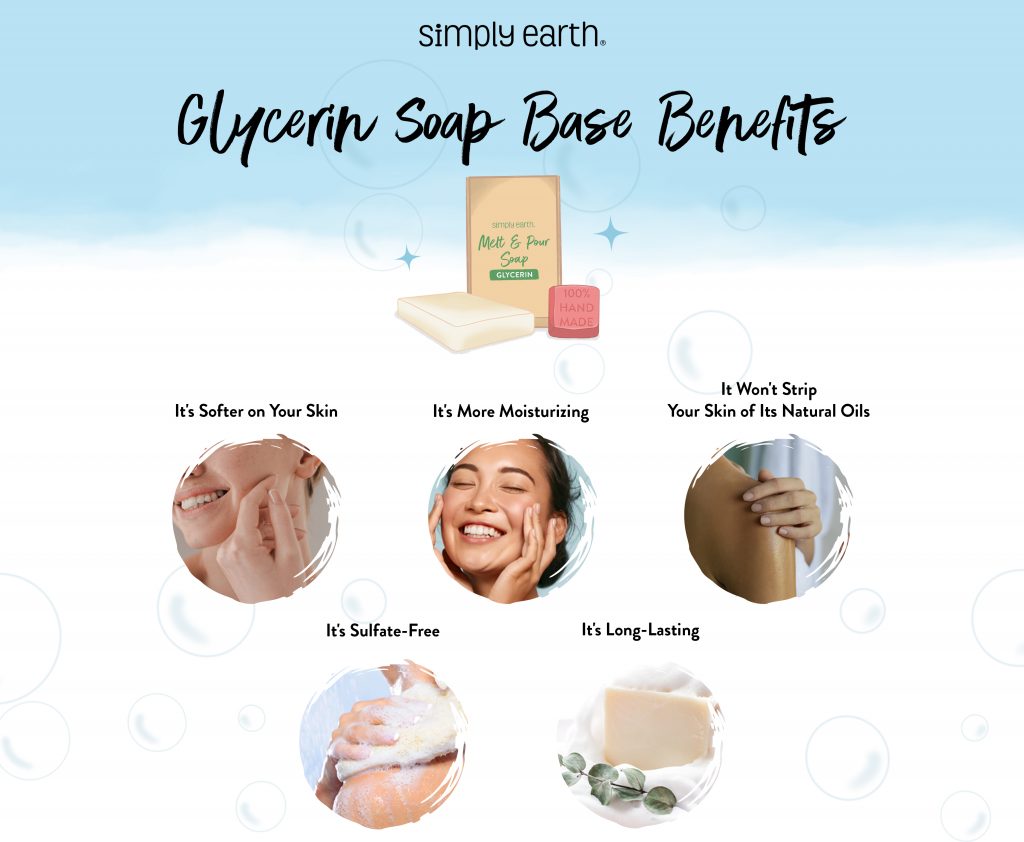
Are you looking for a great soap base to start your DIY projects? What is glycerin soap base, and why is it the perfect choice for everyone, from beginners to experienced soapers? If so, then you’ve come to the right place!
In this blog post, I will fill you in on all the basics of glycerin soap and teach you why it’s one of the most popular soap bases. I’ll also show you a few fun recipes using glycerin and break down the ingredients so you know exactly what you’re putting on your body. There’s a bit of science regarding soap making, but don’t worry – we’ve got it covered!
What is Glycerin?
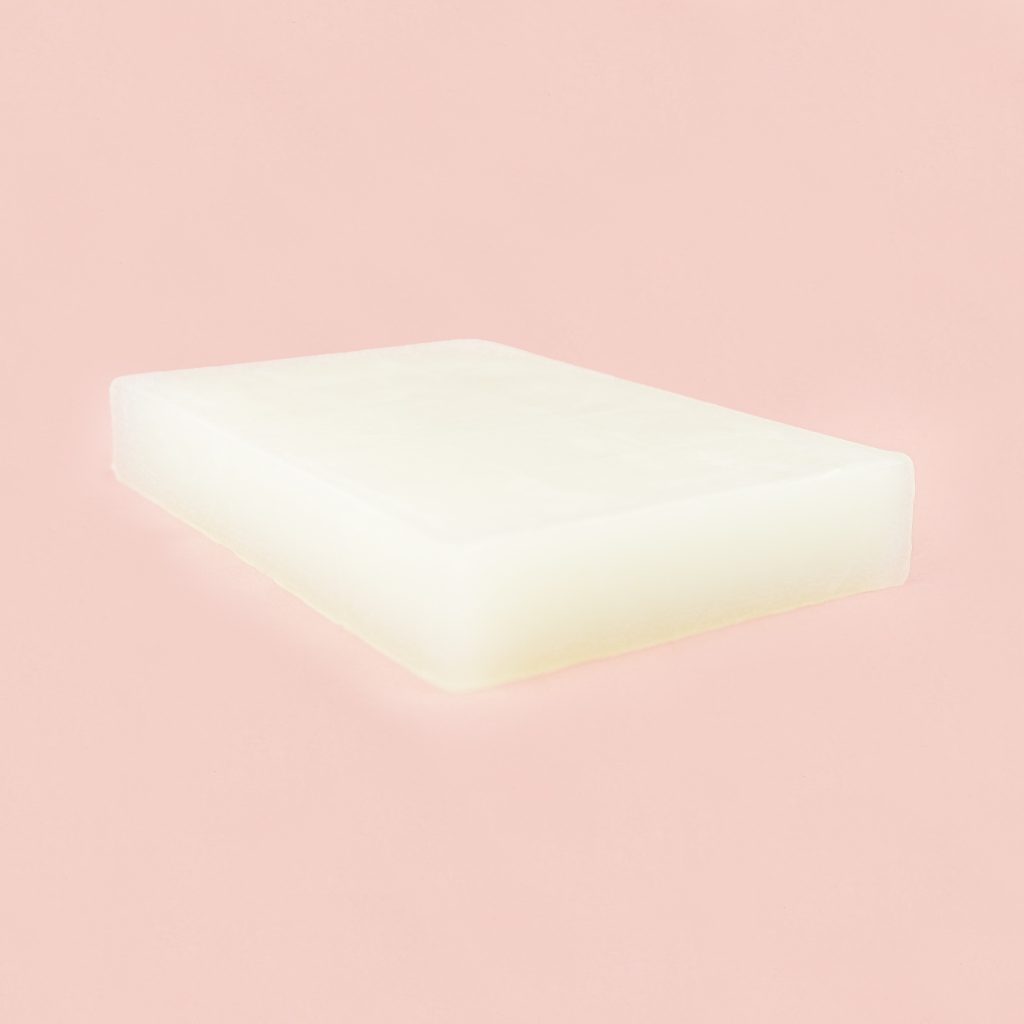
Glycerin, scientifically known as glycerol, is a colorless, odorless component of plant oils and animal fats, which split up during soap or biodiesel production. You may have heard it mostly mentioned in the context of glycerin soap base. However, it’s not just soap either; glycerin is often seen as an ingredient in lotions, toothpaste, and other skincare products due to its humectant capabilities, which helps keep things hydrated!
Glycerin Soap Base Ingredients + EWG Score
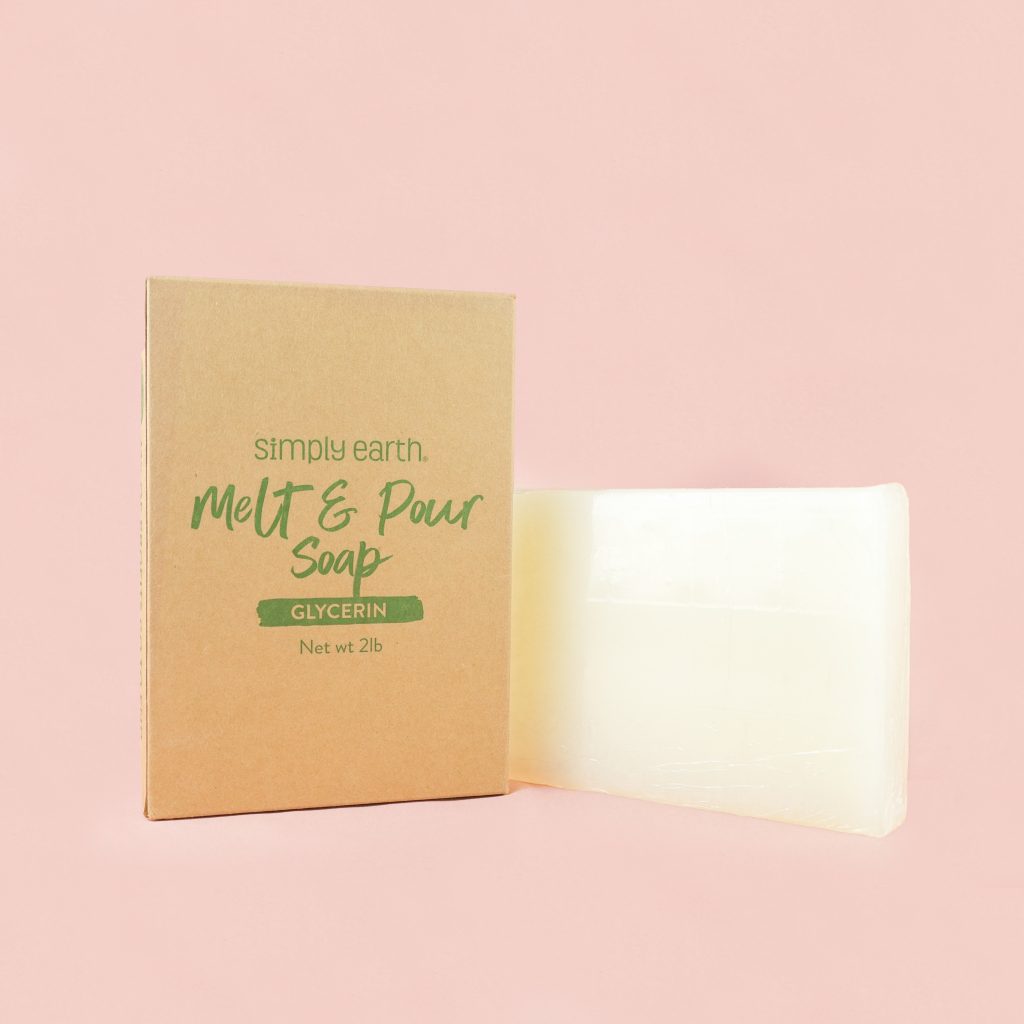
The EWG hazard score, from 1 to 10, reflects known and suspected hazards linked to the ingredients. All ingredients of our Glycerin Soap Base are considered safe and non-toxic per EWG’s strictest criteria for transparency and health.
Sodium Stearate (1)
The key ingredient in glycerin soap base, sodium stearate, is the sodium salt of stearic acid (a naturally occurring fatty acid). It adds an extra level of protection and moisture to your soap while keeping it foamy and luxurious at the same time.
1.3 Butylene Glycol (1)
Butylene glycol, an organic alcohol that goes by many names, such as 1.3 BG, is a popular ingredient in Glycerin Soap Base. It’s great for adding a bit of sleekness and a boost of cleaning power because it acts as a solvent and conditioning agent. Plus, we can rest easy knowing it works to keep the germs away—butylene glycol is an efficient antimicrobial agent.
Glycerine (1-2)
Glycerol, also known as glycerine, is an awesome ingredient. It is colorless, odorless, non-toxic, and has powerful antimicrobial and antiviral capabilities. This makes it an essential component for use in soap bases, as you can be sure you’re getting something that’s not just good for your skin but has the added benefit of keeping germs at bay.
Sucrose (1)
Sucrose is a naturally occurring sugar that can be harvested from various plants, like fruits. It has been used in skincare since ancient times. It adds a pleasant fragrance to your soap base, and its humectant properties also help retain moisture, keeping skin hydrated and happy.
Sorbitol (1)
Sorbitol is a type of sugar alcohol that helps to thicken and condition the skin, giving your soap an extra moisturizing boost. Modern cosmetics rely heavily on this humectant and thickener for its flexible application capabilities – talk about a multi-tasking superhero!
Sodium Alpha-Olefin Sulfonate (1)
Glycerin Soap Base is comprised of sodium alpha-olefin sulfonate, an anionic surfactant. This multipurpose ingredient works wonders, as it can make all kinds of bathroom products and shampoos to keep things squeaky clean, and smelling great.
Sodium Laurate (1)
If you are looking for a powerhouse soap base ingredient, Sodium Laurate is your go-to! This sodium salt of lauric acid checks all the boxes. It can be used as an anticaking agent, lubricant, release agent, and emulsifier, so you know it got lots of uses.
Water
Glycerin soap is a luxurious, dermatologically-friendly bathtime experience that we owe to one special ingredient: water. Sure, there may be other components in the soap base, like surfactants or polysorbates. Still, without water, none of these extras would be able to do their thing to make our skin feel oh-so-smooth and refreshed after an excellent scrub.
Myristic Acid (1)
With its naturally occurring origin in palm oil, coconut oil, and butter fat, Myristic Acid is a special ingredient in soap making. It has cleansing properties and helps create a fluffy lather. In addition, it’s often used as an emulsifier and foam stabilizer, so don’t be afraid to work up a few sumptuous suds with your next attempt at handcrafted soap perfection – you will likely find this powerful little acid in the mix!
Coconut Oil (1)
Coconut oil is an underrated hero in the world of soap-making – and when you choose glycerin soap base for your next batch, you’re getting the best of what this secret agent has to offer. The coconut oil used in the glycerin soap base provides a rich, cleansing lather and boosts much-needed moisture.
Sodium Chloride (1)
To ensure your bars hold their shape and stay solid, try adding just a pinch of sodium chloride – the fancy scientific name for table salt – while melting the soap. With that extra hardening power, you can create beautiful, long-lasting bars of glycerin soap perfectly suited to your unique scent and style.
Denatonium Benzoate (1)
Denatonium Benzoate may not sound like the most pleasant of ingredients, but its addition to glycerin soap base can be a real lifesaver! This bittering agent gives non-edible products an unpleasant taste, making them more challenging for people to ingest accidentally.
Benefits of Glycerin Soap
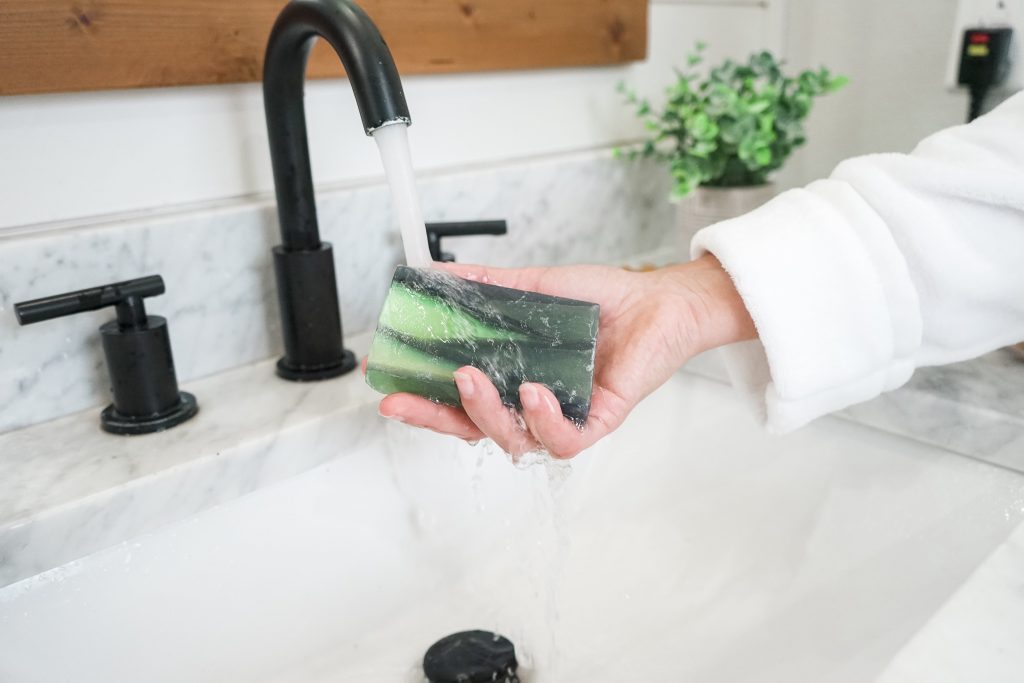
It’s Softer on Your Skin
Glycerin soap is much gentler on your skin than regular soap. This is because it contains glycerin, a natural humectant that helps keep your skin hydrated. Glycerin soap is also non-comedogenic, meaning it won’t clog your pores.
It’s More Moisturizing
Because glycerin soap is more moisturizing, it’s ideal for people with dry skin. The glycerin helps to attract moisture to your skin, keeping it hydrated and soft. Glycerin soap is also less likely to irritate your skin than regular soap.
It Won’t Strip Your Skin of Its Natural Oils
Regular soap can strip your skin of natural oils, leaving it dry and irritated. Glycerin soap, on the other hand, won’t strip away your skin’s natural oils. This makes it an excellent choice for people with sensitive skin or those who want to avoid drying out their skin.
It’s Sulfate-Free
Sulfates are harsh chemicals that are found in some soaps and shampoos. These chemicals can cause some people dryness, irritation, and even allergic reactions. Glycerin soap is sulfate-free, so you don’t have to worry about these potential side effects.
It’s Long-Lasting
Glycerin soap lasts longer than regular soap because it doesn’t dissolve as quickly in water. This means you’ll get more uses out of a bar of glycerin soap than a traditional bar of soap.
How to Use Glycerin Soap Base
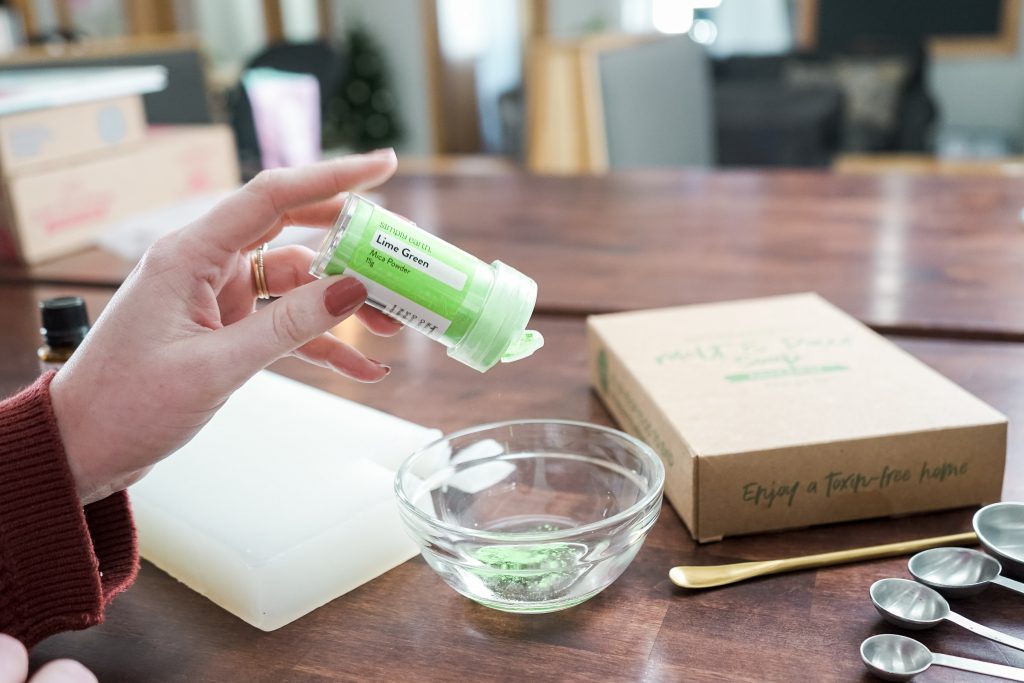
The Glycerin soap base is easy to work with and requires minimal effort to craft. To get started, all you have to do is cut the soap base into small chunks and melt it slowly in a double boiler. From there, you can add other ingredients like colorants, essential oils, or even herbs and flowers to put your own special touch on the soap, then carefully pour the liquified soap into molds. Let it sit until cool, and voilà – handmade soap masterpieces! Soap-making with a glycerin base is a budget-friendly way to bring something personal to your home while demonstrating your creative prowess.
Melt & Pour Soap Cheat Sheet

Making handmade soap can be intimidating if you’ve never done it before. But with this Melt & Pour Soap Cheat Sheet, you don’t have to feel overwhelmed! The cheat sheet provides helpful hints and tips for making beautiful, natural, handcrafted soap at home! Whether you’re a complete beginner or have been making homemade soap for years – this cheat sheet has something for everyone. And who knows, you might even be inspired to write a few of your own soap recipes after perusing the content!

